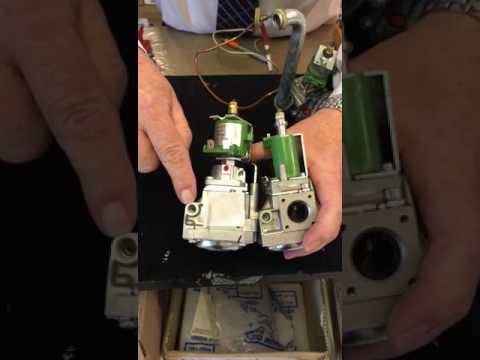Off the cuff Tech Talk no editing Hi guys. There’s been a few questions on a few forums about gas valves, so hopefully this will help.
There’s past and present gas valves here on the table. All still on sale obviously because we’re obliged to keep spare parts for a long number of years, so they’re all still available.
I’ll kick off with the SIT tandem valve. This particular valve was off a heating-only boiler and it was fixed rate on the burner, it wasn’t modulating. This one, with it being a SIT, the blue ignition boiler on the top, if you remember. Now to alter the burner pressure on here, we have a plus and a minus on the screw. Obviously plus increasing the burner pressure and minus decreasing the burner pressure. We no longer use this, as we know, everything’s modulated. But this is still available.
We also used Honeywell one for the fixed rate, and the Honeywell one was like you’d see a gas valve on a BBU, with a plastic cap that you’d unscrew, and screw down to increase and up to decrease, or the opposite way round. You tell me, you’re working on these appliances.
So that was Honeywell and SIT for the fixed rate.
Then we moved on to modulating where the modulator comes into play, and this was the SIT tandem gas valve what they used again with the modulator on the front. If I remove the cap, the brass nut was the high burner pressure and the plastic nut in the middle was the low burner pressure.
Then we move forward … We move on, well, still back in time. This was off the standing pilot light boiler. This was the old single solenoid valve. Where on the modulator we have a brass and a plastic nut. The brass nut was the low burner pressure and the plastic nut was the high. Thermocouple connected to here. The thermocouple is about 18 millivolts when you’re testing. Single solenoid, with about three k across there on the gas valve. Again not used. Just fixed solenoid. Old A2020, not modulating, just step modulating up and down.
So then we move on a little bit further, and here we’ve got the Honeywell gas valve. Again, the brass nut becomes the low burner pressure and the plastic nut becomes the high. Take note on the Honeywell modulator itself, all the modulators are 28 volts DC maximum. So maximum, if the burner pressure’s set right, maximum, it will be maximum at 28 volts. As it modulates, then that … Obviously modulation comes down by reducing the DC, so remember that guys, it’s DC not AC when you’re testing on the modulators. Okay.
If we just look at the solenoid. We have two solenoids. We have a large one and the smaller one. The small one obviously, in days gone by, was the pilot solenoid. But as gas valves came forward and forward, they were still using gas valves with a pilot solenoid and a main solenoid. So the pilot solenoid on here, if we’re doing a resistance test across the pins. Ignore the middle pin, that’s the earth pin. But on the small solenoid we’d expect to see about 3.5k, and on the large solenoid, which is the main solenoid, we’d expect to see about 4.5 – 4.8 in ohms resistance, K, obviously.
Move along. Just one thing worth mentioning. If we look at these Honeywell gas valves, then if you just have a look there, very important. You’ll see there, one has a thread for a pilot tube, and this one doesn’t. The casement of the Honeywell valve is identical, but a totally different valve. Imagine yourself, you’re in a tight cupboard, and you’re fitting a gas valve with a boiler with a pilot tube like this, and then you’re trying to get the pilot tube to fit and you’ve got one without the thread. So worth checking on a Honeywell gas valve, make sure that, obviously if you’re fully electronic you need the one without the thread because you’ve no pilot tube, and for one with a pilot light assembly with a standing pilot or an electronic pilot, make sure you’ve got the one with the thread. There’s nothing worse than fitting it and finding out you’ve got the wrong one.
So again, with this Honeywell gas valve, you’ve got low burner pressure being the brass and the plastic being the high. Now Honeywell about three years ago, they altered the gas valve. What they did, they changed it from brass and plastic, to brass and metal. And not only did they change the material, they changed the way that it sits. So the brass nut becomes the high and the small metal becomes the low. So just remember guys, to check your MI, when you’re actually working on these gas valves, because Honeywell three or four years ago did change that over. Bless ’em. So remember about the thread with the pilot tube.
Right, okay. Move along. We’ve got the Dungs valve. Now you’ll see on the Dungs valve here that both the solenoids are the same size. So when you’re doing a resistance reading, you’ll see that both the coils are exactly the same. And as you can see there, we’re looking about 1.87k. If I check the other one, it’s the same. Okay. Basically, not rocket science.







